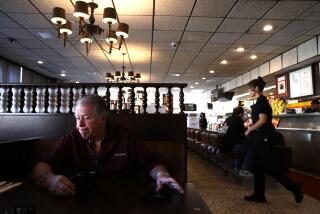City Backs Barracks Rental Proposal to Ease Jail Overcrowding
Fearing that crime in some parts of San Diego is beyond control, a City Council committee Wednesday tentatively approved a measure to rent temporary barracks to house at least 200 prisoners who otherwise might be released from County Jail.
Members of the council’s Public Services and Safety Committee voted unanimously to have City Manager John Lockwood approach county officials and offer to pay $50,000 to $100,000 annually to rent the barracks for three years. The modular buildings would be placed at the County Jail at Las Colinas, in Santee.
In return, the city is asking the county to hire 13 new sheriff’s deputies--estimated to cost $500,000 a year--to handle the extra prisoners.
Lockwood said Wednesday that he does not know whether the county has the money to pay for its share of the proposal but added that Sheriff John Duffy supports the idea.
Rich Robinson, the county’s director of special projects, said money for the extra staffing could be found in the county’s emergency reserve fund. But he added that the county may not be willing to part with the money because it faces other demands for the funds.
“My reading of the board is that it (the jail proposal) is not necessarily going to be a fait accompli ,” Robinson said.
Paying for jail space has traditionally been a county responsibility. But city officials are eager to help out because overcrowding in the jails has meant that only people charged with felonies are detained.
Those charged with misdemeanors--prostitutes, people caught with deadly weapons, scofflaws who fail to appear in court--are generally booked and immediately released. The result of that revolving-door policy has been to create an “epidemic” of crime and to allow some criminals to operate with virtual impunity on city streets, council members said Wednesday.
“As a member of a City Council, I am actually frightened to be in parts of my district,” said Councilman William Jones, who has often complained about the gang and narcotics activity in his Southeast San Diego district.
“I have been intimidated, frankly, by criminals who say that this is their turf, this is their neighborhood, and that ‘Councilman Jones, you are not doing anything about it. Or else.’
“Let’s let the citizens out there know that we’re not going to fool them, that we have things under control. We just don’t have them under control. It’s out of control.”
The proposal also received the strong backing of Mid-City residents who are trying to get rid of prostitution along El Cajon Boulevard.
“We can . . . arrest, and arrest, and arrest . . . but women who are arrested at 9 o’clock in the evening are freed and back on the street by 10 o’clock in the evening, and again by 11 in the evening and forward to until two or three o’clock in the morning,” said Brian Bennet, principal of Blessed Sacrament School at 54th Street and El Cajon Boulevard.
“What we need to do is interrupt the psychology of prostitution by giving a clear message that if you are arrested as a hooker in San Diego, you go to jail.”
The plan for the city to rent temporary barracks was unveiled last week by Lockwood when he, McColl, Councilwoman Judy McCarty and other public officials met with the Mid-City residents about the prostitution problem along El Cajon Boulevard.
Lockwood reported that the county jails are glutted with 81% more prisoners than they are supposed to hold. The state Board of Corrections says the jails should hold at the most 1,689 inmates, but the population now is 3,058.
At Las Colinas, where the temporary barracks would be placed, the women’s jail is 138% over capacity, with 439 prisoners wedged into a building that is supposed to hold 176. Space is at such a premium that 140 prisoners must sleep on the floor each night, Lockwood’s report said.
Because of those conditions, county jail officials are turning away people charged with misdemeanors. Some people who are routinely let go include those picked up for soliciting sexual acts, unlawful entry and detainer, use of a deadly weapon, child molesting, being under the influence of drugs, assault and battery, or failure to appear in court on other criminal charges.
McColl, who chairs the Public Services committee, said the city’s crime rate has skyrocketed since the county adopted the revolving-door policy in 1984. After modest dips in the crime rate in the early 1980s, it increased 5.5% in 1985 and 17.5% in fiscal 1986, she noted.
The city’s plan would try to reverse that by renting the temporary buildings, equipped with air conditioning and heating, and placing them on county land adjacent to Las Colinas.
The modular units would be rented for three years, long enough to ease overcrowding until current or contemplated jail construction adds more than 800 permanent prisoner beds by 1990.
Lockwood proposed 200 additional beds for female prisoners, clearly aiming at complaints about prostitutes.
But after objections from Jones, committee members asked Lockwood to report back in two weeks with another plan to expand the number of beds to 300 for both men and women.
If the council were to stick with the 200 beds, most of them would be taken immediately by the 140 prisoners now sleeping on the floor at Las Colinas, said Cmdr. Melvin E. Nichols, in charge of the county’s jail operations. That would leave a surplus of 60 beds to catch the prisoner overflow, Nichols said.
More to Read
Sign up for Essential California
The most important California stories and recommendations in your inbox every morning.
You may occasionally receive promotional content from the Los Angeles Times.





